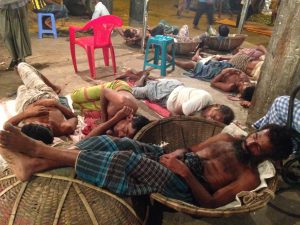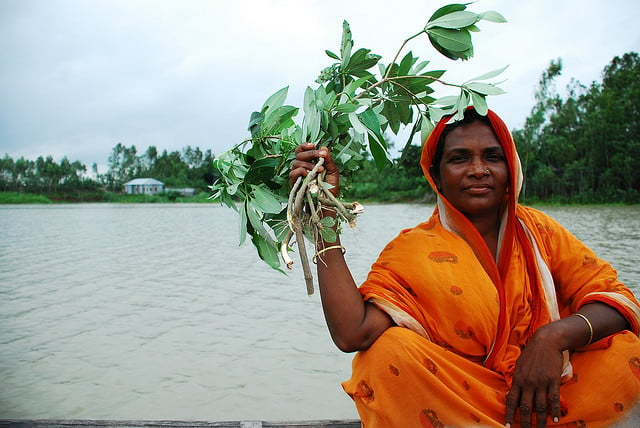It rarely makes news, but a disaster takes place in Bangladesh every monsoon – rivers erode their banks, rendering thousands of people homeless. The surging rivers engulf cropland, houses, schools, markets, temples, mosques and so on. It is such a regular phenomenon it is not even considered a disaster.
Just between them, transboundary rivers Ganga and Brahmaputra – called Jamuna in Bangladesh – and the Padma which is formed when the two meet, erode over 3,000 hectares every monsoon.
“If we count all the rivers, the total area lost would be around 5 to 6,000 hectares every year,” said Maminul Haque Sarker, deputy executive director of the Bangladesh Centre for Environmental and Geographical Information System (CEGIS).
Seen longer term, the Padma, Ganga and Jamuna have taken away around 150,000 hectares in the last four decades.
Rivers eroding one bank while depositing silt on the other is a common phenomenon known in many parts of the world – especially deltas – for centuries. But now the trouble is, in the last 40 years or so the deposition has been only 53,000 hectares, just a little over one-third of the erosion.
“The rest of the land remains in the riverbed as the river has been widening every year eroding its bank,” said Sarker.
The Jamuna is the most erosion-prone river in Bangladesh, just as it is in India, where it is called the Brahmaputra. In Bangladesh, the river’s width can vary between five and 12 km.

Sarker and his colleagues in CEGIS have been studying river erosion for some years now. This year, they predicted that 3,700 hectares on the banks of Padma, Meghna, Jamuna and Ganga were at risk. Though meteorologists had forecast a below-average monsoon in South Asia this year, Bangladesh experienced floods for three weeks, starting mid-August, especially in the northern part of the country. Around three million people were affected, and once again, an estimated 66,000 of them lost their homes due to erosion, and ended up in the slums of Dhaka.
One of them is Alamin Mia, now working as a day labourer in Karwan Bazar, a wholesale vegetable market. “The Jamuna has eroded our home this year,” Mia told
The home was in Bogra district, about 175 km north of the capital. “We shifted the corrugated tin and other material of our house but are yet to rebuild it. Now my family is living in a temporary shelter on a flood protection embankment.”
Every year over 300 rivers in Bangladesh carry about 3.8 billion tonnes of silt, of which 40-45 million tonnes get deposited on the riverbeds. No government agency keeps a record of how much land is being lost to erosion. Shamsul Huda, executive director of the Association for Land Research and Development – an organisation that has been working for landless people – says river erosion is such a disastrous incident that a family may loss all its property in a just a few days or weeks.
And it is happening to 200,000-300,000 families in Bangladesh each year, with an estimated one third of them becoming destitute. Many of the victims lose their homes several times.

“We had to move three times in nine years as the Jamuna continues to erode its bank in our village. Once the bank erodes, we move a little bit further and set up our house,” said Kalam from Vatikul village of Jamalpur district. Now he works as a labourer in Karwan Bazar. “We do not have the money to buy land and build our house in a safer place.”
Kalam and his elder brother Akram moved to Dhaka when the Jamuna eroded their three bighas (0.6 acre) of cropland and also their homestead nine years ago.
As far back as 2001, the World Disaster Report published by the International Federation of Red Cross and Red Crescent Societies said that a million people are affected by river bank erosion and 9,000 hectare cultivable lands are banished in river each year in Bangladesh. Of those, 500,000 are made homeless and the rest never find adequate shelter.
“It is the biggest problem in Bangladesh… and hardly anyone has been shouting about it. It is an abrogation of humanitarian duty,” the report said.
The beginning of change
But now the CEGIS project may be heralding the beginning of change. The erosion warning the scientists have been providing for the last few years allow better disaster management.
The warnings are detailed. A CEGIS report said this June that major bank erosion would take place at 48 places along a 210 km stretch of the Jamuna, Ganga, Padma and Meghna. Of the area likely to be lost, 485 hectares have human settlements and structures including 64 schools, 40 mosques and 12 government and non-government offices.
Sarker told thethirdpole.net that erosion would happen, as rivers in Bangladesh are “morphologically highly dynamic. The type of sediments coming down from the Himalayas through the rivers of Bangladesh is easily prone to erosion. The formation of sediments here is different than many other areas which cause much erosion in Bangladesh.” Especially in the monsoon, the immense water flow increases erosion, he said.
Every year, the government has to allocate a large chunk of the annual development budget for construction, repair and maintenance of riverbank embankments to save establishments from erosion and floods. Finance Minister A.M.A. Muhith has announced that 1,209 km of embankment would be built and 15,358 km repaired in the 2014-15 financial year (April to March). In the same period, 4,540 flood control structures would be built or repaired, he told parliament.
With a better forecast, Bangladesh may be able to reduce this expense significantly.


